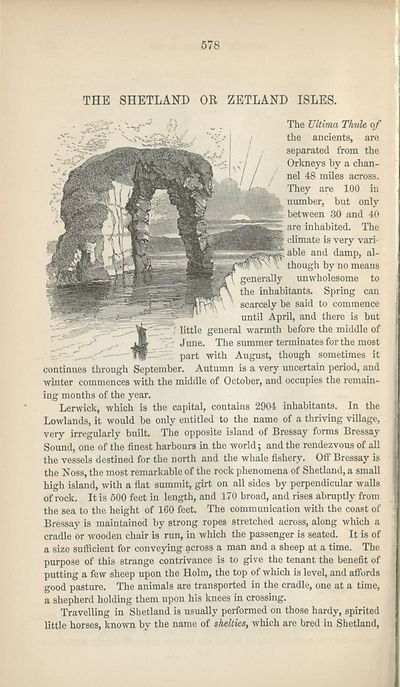Download files
Complete book:
Individual page:
Thumbnail gallery: Grid view | List view

578
THE SHETLAND OR ZETLAND ISLES.
The Ultima Thule of
the ancients, are
separated from the
Orkneys by a chan¬
nel 48 miles across.
They are 100 in
number, but only
between 30 and 40
are inhabited. The
climate is very vari¬
able and damp, al¬
though by no means
generally unwholesome to
the inhabitants. Spring can
scarcely be said to commence
until April, and there is but
little general warmth before the middle of
June. The summer terminates for the most
part with August, though sometimes it
continues through September. Autumn is a very uncertain period, and
winter commences with the middle of October, and occupies the remain¬
ing months of the year.
Lerwick, which is the capital, contains 2904 inhabitants. In the
Lowlands, it would be only entitled to the name of a thriving village,
very irregularly built. The opposite island of Bressay forms Bressay
Sound, one of the finest harbours in the world; and the rendezvous of all
the vessels destined for the north and the whale fishery. Off Bressay is
the Noss, the most remarkable of the rock phenomena of Shetland, a small
high island, with a flat summit, girt on all sides by perpendicular walls
of rock. It is 600 feet in length, and 170 broad, and rises abruptly from
the sea to the height of 160 feet. The communication with the coast of
Bressay is maintained by strong ropes stretched across, along which a
cradle or wooden chair is run, in which the passenger is seated. It is of
a size sufficient for conveying across a man and a sheep at a time. The
purpose of this strange contrivance is to give the tenant the benefit of
putting a few sheep upon the Holm, the top of which is level, and affords
good pasture. The animals are transported in the cradle, one at a time,
a shepherd holding them upon his knees in crossing.
Travelling in Shetland is usually performed on those hardy, spirited
little horses, known by the name of shelties, which are bred in Shetland,
THE SHETLAND OR ZETLAND ISLES.
The Ultima Thule of
the ancients, are
separated from the
Orkneys by a chan¬
nel 48 miles across.
They are 100 in
number, but only
between 30 and 40
are inhabited. The
climate is very vari¬
able and damp, al¬
though by no means
generally unwholesome to
the inhabitants. Spring can
scarcely be said to commence
until April, and there is but
little general warmth before the middle of
June. The summer terminates for the most
part with August, though sometimes it
continues through September. Autumn is a very uncertain period, and
winter commences with the middle of October, and occupies the remain¬
ing months of the year.
Lerwick, which is the capital, contains 2904 inhabitants. In the
Lowlands, it would be only entitled to the name of a thriving village,
very irregularly built. The opposite island of Bressay forms Bressay
Sound, one of the finest harbours in the world; and the rendezvous of all
the vessels destined for the north and the whale fishery. Off Bressay is
the Noss, the most remarkable of the rock phenomena of Shetland, a small
high island, with a flat summit, girt on all sides by perpendicular walls
of rock. It is 600 feet in length, and 170 broad, and rises abruptly from
the sea to the height of 160 feet. The communication with the coast of
Bressay is maintained by strong ropes stretched across, along which a
cradle or wooden chair is run, in which the passenger is seated. It is of
a size sufficient for conveying across a man and a sheep at a time. The
purpose of this strange contrivance is to give the tenant the benefit of
putting a few sheep upon the Holm, the top of which is level, and affords
good pasture. The animals are transported in the cradle, one at a time,
a shepherd holding them upon his knees in crossing.
Travelling in Shetland is usually performed on those hardy, spirited
little horses, known by the name of shelties, which are bred in Shetland,
Set display mode to:
![]() Universal Viewer |
Universal Viewer | ![]() Mirador |
Large image | Transcription
Mirador |
Large image | Transcription
| Antiquarian books of Scotland > Scotland/Scots > Black's picturesque tourist of Scotland > (712) |
|---|
| Permanent URL | https://digital.nls.uk/130036734 |
|---|
| Description | Thousands of printed books from the Antiquarian Books of Scotland collection which dates from 1641 to the 1980s. The collection consists of 14,800 books which were published in Scotland or have a Scottish connection, e.g. through the author, printer or owner. Subjects covered include sport, education, diseases, adventure, occupations, Jacobites, politics and religion. Among the 29 languages represented are English, Gaelic, Italian, French, Russian and Swedish. |
|---|

